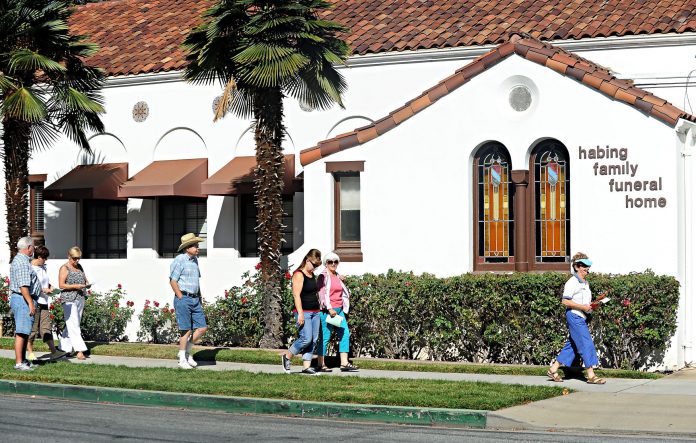
Have you ever driven down a street you use all the time and notice something you’ve never seen before? Has that charming little house down the road always been there? It’s funny how we can go through life with blinders on. Funnier still is how we can live in an area for years and know next to nothing about local history. There is more to Gilroy than just garlic.
The Gilroy Museum offers a free walking tour the first Saturday of every month, when people gather and explore a different historical aspect of the city. Tours include everything from cemeteries to historic homes, and tour guides explain architecture and share information on previous homeowners and their influence in the city.
According to a copper plaque on the stairs to its entrance, the museum—located at 195 Fifth St.—is on the National Register of Historic Places.
But before it was a museum, it was the city library.
From 1890 to 1915, businessman and philanthropist Andrew Carnegie offered grants to cities to build libraries—with conditions: the plans had to be approved beforehand and designs had to lean toward classical style. Carnegie believed that such a style would withstand the tests of time.
The City Council was reluctant to take Carnegie’s grant for the library until Gilroy resident Caroline Hoxett donated the land her tennis court sat on. The building, designed by William Weeks, was built in 1910.
The interior space is tiny but is put to good use: cases display items ranging from American Indian weapons to a robin’s egg blue embroidered wedding kimono from Japan.
On a recent tour exploring the historic homes on Church, Rosanna and Hannah streets, the group was an eclectic mix of 10, including tour guide Connie Rogers and her assistant. Attendees ranged from a couple who has lived in the area for 50 years to a woman who had just moved to the area and wanted to get the lay of the land. Although a diverse group, they had one thing in common: all of them were eager to learn something new.
Walking tour groups are generally not allowed inside the homes, but a couple who recently purchased two historical houses on two lots allowed the group inside to explore. Attendees were greeted by some stunning features, including wooden support beams from a mine that support the ceiling.
The tour included everything from Victorian homes built in the late 1800s to bungalows from the 1920s. The architecture of each home reflected the times and attitudes of the country. Homes built prior to World War I had large and welcoming porches, which made for good places to meet with friends and neighbors. After WWI, porches were often built in back of the houses and were more closed off—much like the country was at the time.
During tours, the guides will share other interesting tidbits of information. According to Rogers, from 1865 to 1882, Gilroy was called the Tobacco Capital of the World and was the home of the world’s largest cigar factory. JD Culp developed a new way to dry the leaves and got a patent, but eventually locals started to complain about the Chinese laborers working at the factory. According to Rogers, after firing all of his Chinese employees, Culp tried to hire the instigators who then refused to do the work and tobacco’s reign ended. Garlic gained a foothold in the early 1900s.
Rogers said the city prohibits homeowners from changing the exterior of historic homes, though the interior is fair game. Each home encompasses the blood, sweat and tears of its current owners and of Gilroy residents from the past.
The Gilroy Museum and its volunteers are dedicated to keeping the past alive and educating the community. The next tour is scheduled from 10 a.m. to noon Nov. 1 and will showcase St. Mary Cemetery. Meet in front of the Serra Cottage, 7950 Church St. For reservations, call (408) 846-0446.
The next Historical Walking Tour will be held Nov. 1 and will feature Old St. Mary Cemetery, the museum’s most popular tour. Among the graves are those of John Gilroy, Father Hudson, Jose Maria Amador and Catherine O’Toole Murphy Dunne. Meet at 10 a.m. in front of the Serra Cottage, 7950 Church St. Reservations are appreciated by calling (408) 846-0446.












